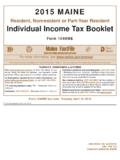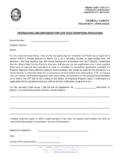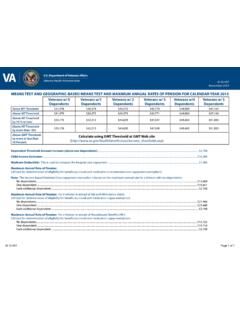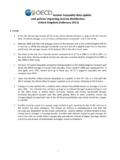Transcription of Corporate income tax rates for active business …
1 Corporate income tax rates for active business income * 2017. Includes all rate changes announced up to 30 June 2017. Manufacturing and income eligible processing (M&P) General income for small- business income not eligible not eligible for deduction (SBD) for federal SBD SBD. (generally up to $500,0001) (greater than $500,000) (non-M&P income ). % % %. Federal rates2 Combined federal and provincial rates : Newfoundland and Labrador4 Prince Edward Island Nova Scotia 1 New Brunswick - Prior to 1 April 2017 - After 31 March 2017 - Calendar year-end rate Quebec Ontario Manitoba (up to $450k)1/ ($450k 500k). Saskatchewan9. - Prior to 1 July 2017 - After 30 June 2017 - Calendar year-end rate Alberta British Columbia - Prior to 1 April 2017 - After 31 March 2017 - Calendar year-end rate Northwest Territories Nunavut Yukon12. - Prior to 1 July 2017 - After 30 June 2017 - Calendar year-end rate Non-resident N/A * rates represent calendar-year rates unless indicated otherwise. Notes: 1.
2 The federal small- business limit is $500,000. As part of its 2017-18 budget, Nova Scotia proposed to increase the small- business limit from $350,000 to $500,000, effective 1 January 2017. However, on 30 April 2017, the Nova Scotia legislative assembly was dissolved and a general provincial election was called for 30 May 2017, which resulted in the re-election of a majority Liberal Party government. Therefore, it is expected that Nova Scotia will proceed with this proposal. Manitoba increased its small- business limit from $425,000 to $450,000, effective 1. January 2016. In its March 2016 Economic and Fiscal Update, the former Manitoba government announced it would further increase the small- business limit from $450,000 to $500,000 effective 1 July 2017. However, this proposal was not confirmed by the new government in its 2016-17. budget, or in its 2017-18 budget tabled on 11 April 2017. The small- business limit for the remaining provinces and territories is $500,000.
3 2. A federal general rate reduction of 13% applies to the base federal rate of 28% for active business income not eligible for other incentives, as well as to investment income earned by a non-Canadian- controlled private corporation. income earned by a personal services business does not benefit from the federal general rate reduction. Consequential to the 2016 increase in the top marginal personal income tax rate, the tax rate on personal services business income earned by a corporation increased to 33% from 28%, effective 1 January 2016. The federal rate applicable to investment income earned by Canadian-controlled private corporations (CCPCs) is (increased from effective 1 January 2016) due to the additional refundable federal income tax, which was increased from to effective 1 January 2016. 3. The 2015 16 federal budget announced a gradual reduction in the small- business rate from 11% to 9% over four years, effective 1 January of each year, based on the following schedule: 2016.
4 ; 2017 10%; 2018 ; and 2019 However, the 2016-17 federal budget has cancelled these scheduled reductions and announced that the small- business tax rate will remain at after 2016. The federal SBD is reduced if taxable capital employed in Canada exceeds $10 million in the preceding taxation year. An SBD reduction for large CCPCs applies in all provinces and territories. The SBD generally applies to M&P income within the small- business income limit, except in the Yukon (see note 12 below) and in certain circumstances in Quebec (see note 7 below). 4. In accordance with its 2016-17 budget, Newfoundland and Labrador increased the general Corporate income tax rate from 14% to 15% and eliminated the M&P profits tax credit, retroactive to 1 January 2016. 5. The New Brunswick small- business rate was reduced from to effective 1 April 2017. In its 2017 18 budget, the province confirmed its previously announced intention to decrease the small- business rate to over the course of the current government's mandate.
5 6. New Brunswick increased the general Corporate income tax rate from 12% to 14%, effective 1 April 2016. 7. Effective for taxation years beginning on or after 1 January 2017, a Canadian-controlled private corporation (CCPC) must meet certain qualification criterion concerning the minimum number of hours worked or be a CCPC in either the primary ( agriculture, forestry, fishing, hunting and certain resource-based sectors) or M&P sectors to benefit from the small- business tax rate. The minimum number of hours worked criterion requires than an eligible corporation's employees work at least 5,500 hours annually, and the amount of the deduction is reduced linearly when the hours are between 5,500 and 5,000 hours. As part of its 2017-18 budget, Quebec has proposed to replace its minimum number of hours worked criterion with a minimum number of hours paid criterion, effective for taxation years beginning after 31 December 2016. New rules will apply in respect of this qualification criterion, in particular a maximum of 40 hours per week per employee 2.
6 Will be considered. The thresholds of 5,500 and 5,000 hours will be kept for purposes of the new qualification criterion. CCPCs engaged in M&P activities in Quebec may be eligible for an additional 4% reduction in the small- business rate. This additional deduction is extended to CCPCs in the primary sector effective for taxation years beginning on or after 1 January 2017. The additional deduction rate reaches 4% where the proportion of activities in the primary or M&P sectors is 50%. or more, and is reduced linearly where the proportion is between 50% and 25%. 8. In accordance with its 2015 16 budget, Quebec is gradually reducing the general Corporate income tax rate from to over four years, effective 1 January of each year beginning in 2017 and based on the following schedule: 2017 ; 2018 ; 2019 ; and 2020 9. In accordance with its 2017-18 budget, Saskatchewan is reducing its general Corporate income tax rate from to effective 1 July 2017, resulting in an effective tax rate of for the 2017 calendar year.
7 Saskatchewan will further reduce its general rate from to effective 1 July 2019. The province will maintain the manufacturing and processing (M&P) profits tax reduction at 2%. The tax rate on Saskatchewan M&P profits is thereby reduced to effective 1 July 2017, and further reduced to effective 1 July 2019, with an effective tax rate of for the 2017 calendar year. 10. Alberta reduced the small- business rate from 3% to 2% effective 1 January 2017. 11. As part of its 2017-18 budget, British Columbia proposed to reduce its small- business rate from to effective 1 April 2017. This proposal was substantively enacted on 21 February 2017. when Bill 8, Budget Measures Implementation Act, 2017, received first reading. However, the legislative assembly was dissolved on 11 April 2017 when the 9 May 2017 election was called, and Bill 8 died on the order paper. The election returned a minority government, which was subsequently defeated in a non-confidence vote held in the legislature on 29 June 2017.
8 The New Democratic Party (NDP) is expected to form a minority government in July. Since the NDP election platform supported a half percentage point reduction in the small- business rate, it is expected that the NDP will proceed with the proposal that was included in Bill 8. 12. The Yukon M&P rate is less than the small- business rate. The first rate applies to M&P income eligible for the SBD, while the second rate is for non-M&P income . Effective 1 July 2017, Yukon is reducing its small- business rate from to and its general rate from to However, the M&P tax rates are maintained at for M&P income that is eligible for the SBD, and for M&P income that is subject to tax at the general rate. These changes were announced as part of Yukon's 2017-18 budget. 3.














